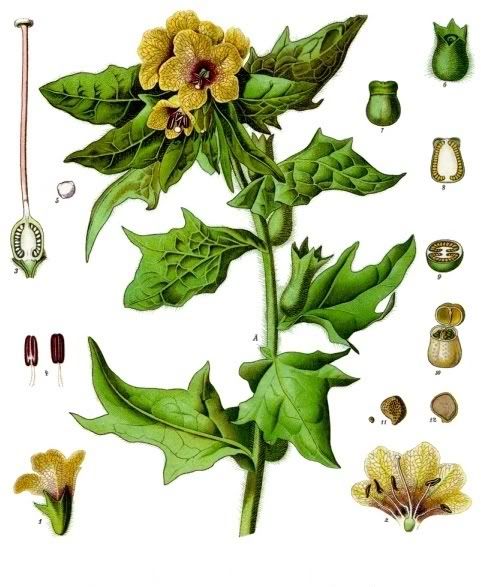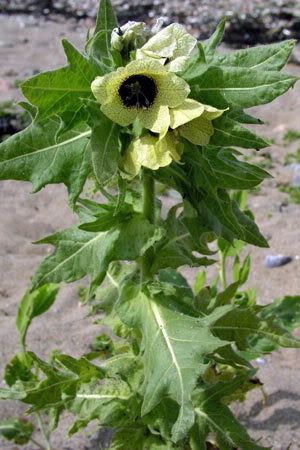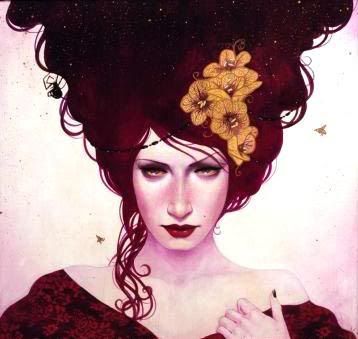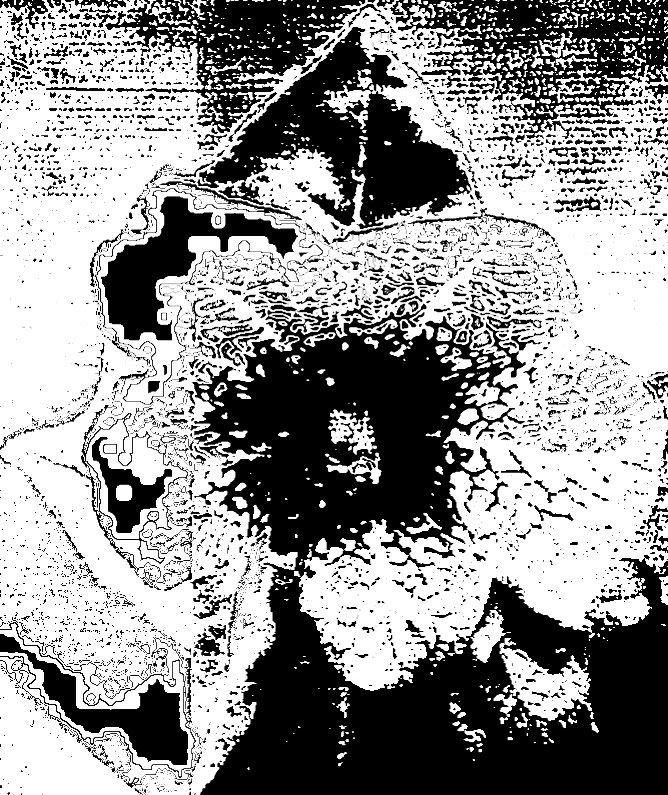
Among other herbs which are poisonous and harmful, Henbane is not the least, so that the common man, not without fear should spit at that herb when he hears its name spoken, not to mention when he sees it growing in great quantity where his children are running at play."
Fear and loathing are the usual responses to this not altogether innocent herb of the nightshade family. All too often is it described as a noxious, evil-looking and poisonous weed that is best avoided. Herbalists of all periods have painted our mental image of this herb in non too flattering terms: A filthy looking plant, covered with sticky hairs, its gray-green, sharply toothed leaves are limp and liverish in appearance. The flowers are bell-shaped, dirty yellow or sickly pale purple and marked with deep purple veins. The whole plant, according to some authors, looks and smells like death. As if that wasn't enough, further evidence of its devilish nature is revealed by the places where it chooses to grow: the rubbish heaps of civilization, ditches and dumpsters, waste-grounds, among the ruins of old castles and monasteries, and most especially, it loves to grow in graveyards.

There are about a dozen distinct species of Hyoscyamos, though it appears that historically only four of them played an important role: H. niger, H. alba, H. aurea and H. muticus. Although it is impossible to determine exactly where Henbane first originated, it is generally thought that it came from the Mediterranean regions of Asia Minor and northern Africa, from where it spread east to Pakistan, India and China. Its migration to the northern latitudes of Europe seems to have occurred at a slightly later date. Some sources claim that the Gypsies were largely responsible for bringing it to Scandinavia and the British Isles. As for its arrival on the American shores, it is generally believed that it came with the Spaniards. Native healers and shamans soon adopted the plant and began to use it much like their European counterparts.
Powerful plants are always treated with suspicion for it is entirely in the hands of the practitioner, whether they will heal or harm. The voices of prudence, campaigning for the eradication of toxic plants, often argue that innocent people and children, who know nothing of their poisonous properties, may inadvertently fall victim to such plants. However, such an attitude is borne out of ignorance. Education, not prohibition or elimination is the best safeguard against accidental poisoning. As Paracelsus rightly said - all things are poison, the dosage alone determines whether a substance kills or cures. Henbane is no exception to this rule.
From time immemorial to the present day, Henbane has played a significant role as an important medicinal and magical plant. Like its cousins, the Deadly Nightshade (Atropa belladonna) and the Thornapple (Datura stramonium), it contains a potent mixture of tropane alkaloids (Atropine, Scopolamine and Hyoscyamine,) which block the normal neurotransmission of the parasympathetic (involuntary) nervous system and thus, even small quantities can produce rather drastic effects.

When ingested in toxic quantities, the symptoms are: increased rate of heartbeat, dry mouth, dilated pupils, impaired vision, general sense of weakness and debility, headache, dizziness, difficulties in swallowing, stomach cramps, body aches and pains, increased temperature with hot flashes and reddened skin, agitated excitement, sometimes aggressive rage, convulsions, confusion, hallucinations, followed by deep sleep, delirium, or in severe cases, death. The most significant psychotropic effects of Henbane are: A sense of body dissolution or distortion, the sensation of flying and erotic hallucinations. Also remarkable is the total oblivion that follows the period of intoxication. Frequently, the next day the person remembers nothing of what happened.
It is obvious how these properties could easily be abused and why this plant acquired such a sinister reputation. Nevertheless, compared to Deadly Nightshade and Datura, Henbane is perhaps the least toxic, thanks to the fact that it contains relatively little Atropine, the most dangerous of these alkaloids. Indeed, few cases of either accidental or intentional poisoning with Henbane have ever been fatal. The synergy of alkaloids in Henbane is fortunate in that they work quite complementary. Scopolamine acts as a narcotic, somniferant, and anodyne, while Hyoscyamine has a relaxant effect on involuntary muscles and checks mucous secretion. The roots are considered the most potent part of the plant. Egyptian Henbane (H. muticus) is stronger than common Black Henbane (H. niger) and it is from this species that most commercial Scopolamine is derived.
The colorful, though often tragic history of the medicinal and magical uses of Henbane can be traced a long way back. The oldest surviving record, dating to 4000 BC, stems from an inscription on a Sumerian clay tablet. It is also mentioned in the famous Ebers Papyrus (Egypt, 1500 BC), along with other important medicinal herbs. The Egyptians knew it as 'Sakran' - 'The Drunken', no doubt referring to the plant's intoxicating properties, but perhaps also as an allusion to the ancient practice of fortifying alcoholic beverages with its seeds. This practice was very common. Dioscorides mentions a similar potion, a honey-mead prepared with Opium and Henbane seeds. Henbane-spiked mead was particularly popular among the Celts and Germans - accounts of their notorious drinking orgies bear witness to this fact. Henbane seed has also long been used as an additive for brewing beer. In fact, the name of the Czechoslovakian town of Pizen (German: 'Pilsen') is said to be derived from the word 'Bilsen' the German name for Henbane. Apparently the beer brewed there, known as 'Pilsener', was famous for its 'Bilsen'-induced effects. Eventually however, the authorities put an end to this practice by implementing the first 'anti-drug law' in 1516, known as the 'Deutsches Reinheitsgesetz' ('beer purity law). Modern day Pilsener beer no longer contains any trace of Henbane.
The ancient Greeks knew Henbane as 'Apollinaris' and considered it sacred to Apollo. Many scholars now believe that Henbane played an instrumental part at Apollo's oracle in Delphi. The descriptions of the ecstatic state in which the oracle-priestess Pythia proclaimed her prophecies and reports of 'heavy fumes' during the ritual, leads them to suspect that Henbane seeds were used as incense. Henbane is well known for inducing states of ecstasy, a condition that used to be regarded not so much as a temporary state of derangement, but rather as a state of mind that touched upon the divine. Some writers muse that the scientific name 'Hyoscyamos', which translates as 'Hogbean' might perhaps be a corruption of 'Dioscyamos' which would translate as 'Divine Bean', a reasoning that, considering its status as a sacred plant, makes somewhat more sense. Furthermore, the rationalizations given for 'Hogbean' are rather contradictory. Some writers claiming that refers to the fact that pigs are supposedly immune to the plant, while others directly dispute this claim, stating that it causes them cramps. Still others believe that it refers to the story of Circe, who might have used Henbane to turn Odysseus men into pigs. However, Ovid does not mention Henbane directly, but only refers to 'a brew made from magical herbs'. It is interesting to note that the Celts, too considered the plant sacred to their God of prophecy. According to Dioscorides they called it 'Belenuntia', herb of Bel, which still echoes in 'Beleño', the Spanish name for Henbane.

For medicinal purposes Dioscorides recommends Henbane 'to allay pain and procure sleep'. Other common applications included an oil made from the leaves for treating obstinate rheumatic pains, gout, neuralgia and sciatica. Ulcerous wounds and swelling were dressed with a poultice made from its leaves. It was rarely taken internally, though, except for cases of severe stomach or urinary cramps, when a very dilute extract could be administered. Smoking the leaves mixed with Horehound (Marrubium vulgare) and Coltsfoot (Tussilago farfara) was a popular remedy for asthma and nervous or spasmodic cough. Taken in small quantities this would not produce a significant psychotropic effect, but relax the respiratory muscles while simultaneously reducing the secretion of the mucus membranes.
It seems that one of Henbane's most common uses was as a treatment for toothache. It was once commonly believed that toothaches and other maladies were caused by worms. It was thought that the tiny eggs of such worms were inhaled and subsequently lodged themselves in the mouth, where they later hatched and caused toothache. * While some sources simply recommend an extract of Henbane to be applied to a painful tooth (a rather risky treatment), others recite a more fanciful procedure. Gerard describes it in contemptuous terms:
'Drawers of teeth, who run about the country and pretend they cause worms to come forth from the teeth by burning the seed (of henbane) in a chafing dish of coals, the party holding his mouth over the fume thereof, do have some crafty companions who convey small lute strings into the water, persuading the patient that these little creepers came out of his mouth, or other parts which it was intended to ease.'
Given the powerful psychotropic effects this kind of treatment would doubtlessly induce, it is easy to imagine that the patient would readily believe such a hoax. Henbane root was also given to children as an amulet for easy teething and to prevent fits.

During the Middle Ages, Henbane became best known as a 'Witches Herb'. It is said to have been one of the ingredients of the infamous flying ointment. Reports of their alleged activities were generally obtained by torture at the hands of the inquisition and should thus be treated with a measure of suspicion. However, the descriptions of this potion's powerful effects are indeed very characteristic of Henbane's psychotropic action. A reoccurring theme describes how the Witches used this ointment to transform into various animals and fly away on their broomsticks to attend orgiastic rites. Apparently the broomstick served as the means by which the ointment was applied to the sensitive mucous membranes and thus became the vehicle for an erotic flight of the imagination. Henbane also induces a sense of body dissolution, 'as if the soul separates from the body and flies through the skies' which would account for the witches' subjective shape shifting experience and flight to their fabled Sabbath.
But witches were not the only ones to take pleasure in the aphrodisiac properties of this plant. Apparently, incense prepared from the seeds was commonly burned in mediaeval bath-houses. The ambience there could not have fallen far short of what one might expect from the imaginary orgiastic rites of the witches. Needless to say, the aphrodisiac properties of Henbane were also extensively used in numerous charms and love-potions.
Ironically, records found in Lucerne, Switzerland, dating to the 16th century indicate that witches condemned to death were given a 'draught of compassion' - a witches brew consisting mainly of Henbane that was supposed to induce a state of oblivion and insensitivity to pain.
Perhaps some of our modern uses are not so wildly different to those of the past. Although admittedly, its aphrodisiac and visionary aspects don't figure very prominently anymore, the psychoactive properties are still employed in the treatment of some cases of mental disturbance, especially those characterized by agitation and nervousness. Interestingly, during the 60's it seems to have been 'fashionable' to drug women in labor with Scopolamine, presumably 'soothe their agitation' and render them 'oblivious and insensitive to pain'.
Other modern uses include liniments for rheumatic aches and pains and as spasmolytic medicines for gastro-intestinal cramps, griping, and paralysis of the bladder. Asthma cigarettes containing Henbane leaves have, until recently, also remained quite popular. A homeopathic remedy based on Henbane is still available at health food stores and herb shops.
Henbane has many beneficial uses, but its power must not be underestimated. This plant demands respect. In the hands of a knowledgeable and cautious healer it can be a blessing, but in the hands of irresponsible fools it can wreak havoc and even cause death.

The information given here is purely intended as an account of the ethnobotanical history of this interesting plant. It should not serve as medical advice and self-experimentation is not recommended.
What an informative post Dancing Sister...I have never seen this plant in the wild, although admittedly I've never looked for it either as it has not been in my awareness. Now that it is I shall keep my eyes peeled. Funny too as I have nightshade growing profusely in my yard...just pulled massive amounts of it out two days ago! Little Grandmother no doubt would pull it for its lovely little flower and boy oh boy!
ReplyDeleteI found it interesting about Circe and pigs and men, lol!
Always learning when I stop by here!
Happy Harvesting and Happy Lammas Precious!
xoxoxo
I am learning a lot too... thank you for sharing this medicine sister. Bless...
ReplyDeleteAs kids we loved to use the little green seed pods (and later the dry version too) as "salt and pepper shakers"--the "cap" comes off and the seeds shake out. Ill effects must not be too transferable through the leaf oils; our rural parents certainly never cautioned us.
ReplyDeleteThanks for your great information, the contents are quiet interesting.I will be waiting for your next post.
ReplyDeletejobs in life Sciences
Having grown and used black henbane in brewing, the key is knowing how much is moderate and how much is too much. Moderation yeilds a nice licorace-like flavour and a lucid buzz with interesting dreams. Brewing should enrich life like good food can, not the making of one into a raging lunatic. We lost this heritage due to ignorance and a lack of appreciation for the natural world. It is time we gained it back...
ReplyDelete